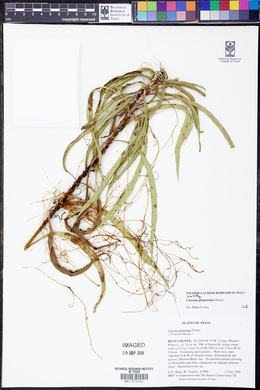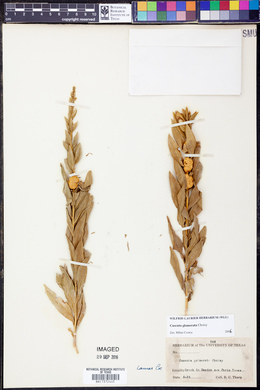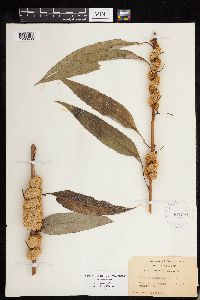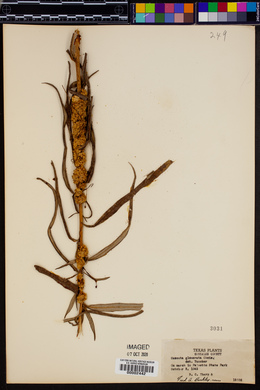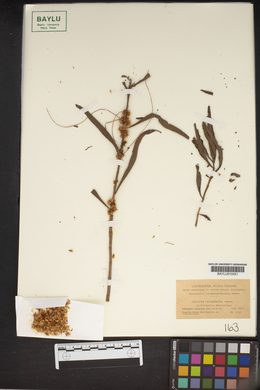Cuscuta glomerata
|
|
|
|
Family: Convolvulaceae
Rope Dodder
[Cuscuta paradoxa Raf., moreLepidanche compositarum] |
Annual parasitic vine over 50 cm long Stem: orange or pinkish yellow, somewhat coarse, climbing on other plants and attaching to them with specialized outgrowths (haustoria) which invade tissue of the host plant to absorb food. Leaves: alternate, orange or pinkish yellow, very small, scale-like. Flowers: numerous, stalkless, whitish, small, 4 - 5 mm tall, radially symmetric, somewhat tubular, with five, spreading, short, pointed petal lobes. Each flower is subtended by several, erect or loosely ascending, oval or oblong, relatively long (about equaling sepals) bracts with slightly recurved tips. Flowers arranged in dense, spirally twisted, rope-like mass all along stem. Sepals: five, fairly erect, long (about equaling petal tube), similarly shaped as bracts, much longer than wide, with somewhat recurved and pointed tips. Petals: five, but fused for most of their length into a tube, then separating into five, spreading, 2 mm long, egg-shaped lobes with somewhat pointed tips. Stamens: five, attached to inside top of petal tube alternating the petal lobes, with very short filaments, but the anthers visible and extending beyond petal tube. Pistil: with one, two-chambered, superior ovary; and two, elongate (1.5 - 3.5 mm long) styles which end in rounded stigmas. Fruit: small, 3 - 4 mm diameter, somewhat rounded, usually two-seeded, membranous capsules with short neck at top. The withered petal tube encloses the whole fruit. Similar species: Cuscuta glomerata is fairly unique among our species of Cuscuta due to its dense, elongate, nearly continuous, winding, rope-like clusters of flowers which obscure the stem. The most similar species is probably C. compacta, which may have occurred at one time in the Chicago Region (see Swink and Wilhelm 1994), however that species differs by having graduated, shingled, appressed, wider than long, and broadly round-tipped bracts. Flowering: July to late September Habitat and ecology: Occasional, typically in low wet areas, locally now in moist prairies in the western part of the Chicago Region, normally growing on composites (Asteraceae family), but also in Indiana known to grow on Apios americana and species of Asclepias. Occurence in the Chicago region: native Notes: This plant is easily recognized from a distance because it looks like a white, spiraled rope twisting on other plants. Etymology: Cuscuta is an ancient Latin name for dodder, probably of Arabic origin. Glomerata means clustered, in reference to the very tightly arranged and continuous flower clusters covering long lengths of the stem. Author: The Field Museum Fls 5-merous, 4-5 mm, in dense, twisted, rope-like masses, sessile or nearly so; bracts oval or oblong, erect or loosely ascending, about equaling the cal, the tips squarrose or recurved; cor-lobes ovate, subacute, 2 mm; styles elongate, 1.5-3.5 mm; stigma capitate; fr concealed by the withered cor, 3-4 mm thick, subglobose with a short neck, mostly 2-seeded; 2n=30. Ind. to Wis. and N.D., s. to Miss. and Tex. Gleason, Henry A. & Cronquist, Arthur J. 1991. Manual of vascular plants of northeastern United States and adjacent Canada. lxxv + 910 pp. ©The New York Botanical Garden. All rights reserved. Used by permission. From Flora of Indiana (1940) by Charles C. Deam On hosts of low ground, mostly in marshes. Hosts of my specimens are: 1 on Apios, 1 on Asclepias syriaca, 3 on Aster, 4 on Helianthus, and 1 on Solidago. |










